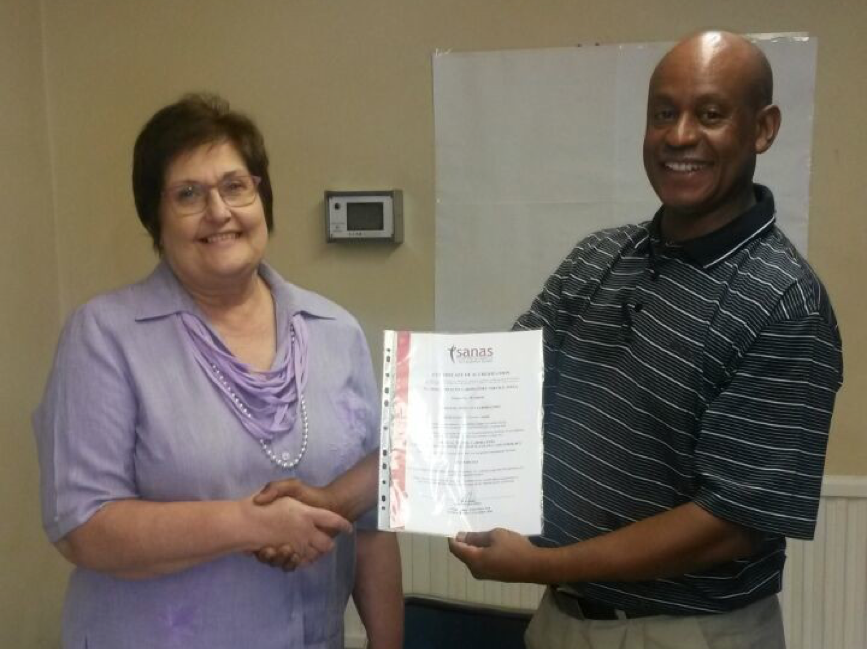NHLS Tshepong Laboratory, South Africa
 |
| Ms. Erna du Plessis (Laboratory Manager, left)) receiving the SANAS certificate from Mr. Stephen Monareng ( Business Manager) |
1.What was the hardest thing to do in order to get accredited?
- Accreditation is a team effort and can’t be achieved by 1 or 2 people alone. By far the hardest thing for me was to get buy in from all my staff and to get them to understand what the quality management system is about and why it is so important to abide by the rules and for them to accept ownership of the system. To achieve this necessitates a change of mind-set, since human nature is such that we tend to try to get away with the least effort possible when doing things. Education and information were found to be important legs for this step and this task will never be complete. In some instances disciplinary action becomes necessary, which I find very unpleasant.
- It is also very hard to implement all the paper work when you start from scratch.
- It is difficult to close all the non-conformances in time after audits.
- One of the biggest challenges that I encountered, was to get all staff to read and acknowledge the relevant documents, which is a never-ending struggle.
2.What was the easiest?
The simpler parts of the paperwork, like labelling of instruments and writing of the Books of Life and creating files were the easiest to do.
3.What was the most important contributing factor to getting accredited?
- I found that proper document control was very important, especially compiling a master documents list. After getting this in place, we started to move forward.
- It is also very important to hold regular staff meetings for communication with staff members on what needs to be done and why it is important.
- The Laboratory Manual is very important, should be detailed and is a living document which needs changes all the time.
4.What steps did you take?
There are, to my knowledge and experience, no short-cuts to achieve accreditation.
STEP 1 : Establishing a document control system made a big difference in our laboratory and assisted a lot to achieve accreditation. It took me a long time to grasp what needs to be done in this regard, and I probably will still learn a lot as we go.
STEP 2 : The Management Review Meeting played a big role in order to identify shortfalls that we needed to concentrate on.
STEP 3 : “Burning the midnight oil” - the management team had to put in many extra hours to achieve deadlines, e.g. I started spending at least 4 hours of every Saturday afternoon in my office, which helped me a lot to catch up on- and to get paperwork done.
STEP 4 : It further helped to involve other staff members by delegating smaller tasks to them, e.g. the monitoring of maintenance sheets, temperature charts, verifying of pipettes, timers, thermometers.
5.What were the biggest mistakes you made?
The biggest mistake was to be too trusting of others and not to check that tasks that were given to other staff members were done and if done, to check for correctness and completeness.
6.What is the best advice you can give to others?
- Make full use of opportunities like the SLMTA program by fully implementing the quality improvement projects that are identified – these are important steps in getting things in place.
- Appreciate and make full use of the assistance from your mentor, since they have already gone through the whole process.
- See every audit as an opportunity to improve your system and fully co-operate with sustaining the corrective actions put in place during the closing of the non-conformances identified.
- Never relax and think that you are there. This is a living process never completed.
7.How much did it cost?
Fees to the accrediting body (SANAS) was around R 83 000.00. This does not take into account other costs, like the additional paper needed for all the documentation implemented over the years, accommodation and travel expenses to attend courses and for auditors and mentors to visit the laboratory, etc.
